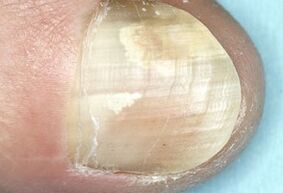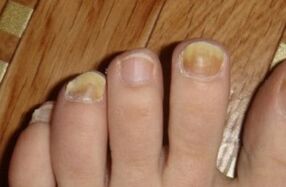
Nail plate fungus on the toes (onychomycosis of the feet) is an infectious disease that manifests itself in damage to the nails by dermatomycetes, mold or yeast-like fungi.According to statistics, the prevalence of this disease among the population is 10%.
The risk of developing onychomycosis of the legs directly depends on the social and climatic conditions where a person lives, his gender, age, occupation and the presence or absence of other diseases.
One way or another, this pathology requires timely detection and competent, comprehensive treatment due to its high infectiousness and the ability to significantly worsen the patient's quality of life.
Symptoms of toenail fungus
Depending on the symptomatic manifestations, there are three types of onychomycosis of the legs:
- hypertrophic;
- normotropic;
- atrophic.
Hypertrophic damage to the nails is characterized by noticeable thickening and deformation of the nail plates, loss of shine and the appearance of a kind of “corrosion” at their edges.The clinical picture of the disease can be supplemented by the appearance of pain and the development of onychogryphosis (a pathology in which the nails take on the appearance of bird claws).
With onychomycosis of the normotrophic type, yellow or white stripes and spots appear on the nail plates.At the same time, the nails retain their shape, shine and thickness.In atrophic onychomycosis, the nail plate quickly separates from the nail bed, becomes dull and takes on a gray-brown color.The exposed skin area is covered with loose hyperkeratotic layers.
Clinical signs of toenail fungus form the basis of a further classification of onychomycosis, which is mainly used by foreign doctors.Based on this typology, 4 forms of the disease can be distinguished:
- distal (damage to the free edge of the nail);
- proximal (damage to the posterior nail fold);
- lateral (damage to the nail from the sides);
- total (damage to the entire nail plate).
When drawing up a therapeutic program, the severity of onychomycosis manifestations must be taken into account.
Toenail fungus treatment

The diagnosis of “onychomycosis of the legs” is made based on the results of a visual medical examination, a PCR test, and microscopic and cultural studies.By carrying out the above-mentioned tests, we can draw conclusions not only about the presence of a fungal infection, but also about the type of pathogen.
Now a few words about how to cure toenail fungus in the shortest possible time.The etiotropic treatment program for onychomycosis includes the use of local and systemic drugs.The most effective means for local treatment of fungus on the toenail plates are:
- antifungal keratolytic ointments, gels and creams;
- Special plaster for mechanical removal of affected nails;
- antifungal varnishes based on ciclopirox, amorolfine or mixtures of salicylic acid, benzoic acid, lactic acid and resorcinol.
Nowadays, systemic therapy seems to be the most relevant for nail fungus.In recent years, a number of general antifungals have been developed that can increase the effectiveness of onychomycosis treatment by up to 90%.
Medication for toenail fungus
Varnishes are considered the most effective antifungal varnishes.The main feature of the products is their ability to destroy pathogens in the deep layers of the nail and penetrate the nail bed.Antifungal creams and ointments include products that contain terbinafine.The listed products are applied daily to the affected nail plates and rubbed gently until completely absorbed.The duration of treatment for onychomycosis with ointments and creams can vary between 2 and 6 weeks.The procedure for using topical antimycotics should be coordinated with a dermatologist beforehand.
The selection of systemic drugs is carried out taking into account the severity of the disease and the presence or absence of contraindications to their use in the patient.
Prevention of toenail fungus
The main measures to prevent the development of onychomycosis of the legs are:
- Avoidance of mechanical trauma to the nail plates;
- Refusal to wear coarse, tight and ill-fitting shoes;
- careful processing of pedicure tools;
- Using individual shoes when visiting baths, saunas and swimming pools;
- Monitoring the health status of pets, timely treatment of identified pathologies;
- Excluded are cases of using other people's toiletries, clothing, towels and shoes;
- timely detection and treatment of diseases;
- Carrying out activities to strengthen the body's defenses.
It is important to understand that self-treatment of onychomycosis often not only does not bring the expected results, but also significantly complicates the course of the disease.Therefore, before using medications or folk remedies for fungus, you should coordinate the treatment program with an experienced dermatologist.

























